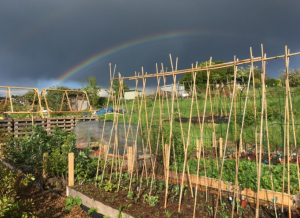Councillors are being asked to look into gardeners’ concerns that allotment plots are lying empty despite a long waiting list.
Members of the Brighton and Hove Allotment Federation shared their concerns online about the number of apparently empty plots on 37 sites, while the waiting list runs to more than 2,000 people.
Conservative councillor Robert Nemeth, whose partner is an allotment holder, is calling for a report on what Brighton and Hove City Council spends on the service, particularly the £17 charge for joining the waiting list.
He has put down a motion for debate on the subject at a meeting of the full council next Thursday (15 July).
He also wants to unearth the number and size of unlettable plots and to ask why joint meetings are no longer taking place between council staff and the Allotment Federation.
Councillor Nemeth asked about the number of unlet plots and waiting list numbers at the council’s Environment, Transport and Sustainability Committee meeting last month.
The council said that, as of Wednesday 16 June, there were 184 unlet plots, compared with 196 vacant plots in January last year.
The waiting list went up from 1,338 on in February last year to 2,385 last month. And last year the council let 135 pots while in the first six months of this year 89 were let.
Volunteers used to handle lettings but, since the coronavirus pandemic started, volunteering has been suspended at City Parks, the council’s parks, gardens and allotments service.
Mark Carroll, who chairs the Brighton and Hove Allotment Federation, said that there were usually 250 vacant plots a year which were let by site reps.
In the past six months, the site reps have not received information about lettings, with the council citing data protection rules – and, now, council officials are managing the waiting list.
Mr Carroll said: “People are up in arms about the numbers of vacant, unlet and overgrown plots across the city, especially considering the waiting list – 2,500 people chomping at the bit to get on those plots, many of them having paid £17 for the privilege of joining the waiting list.”
As plots become overgrown, it makes them harder to let and council workers eventually have to strim the vegetation.
Allotment holder Dominic Furlong has contacted the council with his own concerns about the number of uncultivated plots in Moulsecoomb. He is also concerned that site reps are not able to contact tenants.
Mr Furlong said that he wanted the council to sort out the date protection obstacles “so that site reps are able to contact allotment tenants and co-workers directly, especially since this adds yet another bottleneck to a system which has very low administrative capacity relative to demand”.
He said: “More broadly, the database systems which cover allotment tenancies, co-worker agreement details, plot vacancies, plot size and/or boundaries, waiting lists, annual tenancy payments, etc, often seem inaccurate.”
He was told that there were “12.5 vacant plots” on the Moulsecoomb estate.
The council meeting is due to start at 4.30pm next Thursday (15 July) and is scheduled to be webcast on the council’s website.









Are they planning to evict long-term tenants like they did with the beach huts?
When makeover programs became the thing in the 1990s, homeowners got unrealistic ideas about what they could do with a tatty room – because these TV shows suggested the work could be completed in a day and they rarely mentioned the soaring materials costs.
People now have a similar fantasy about owning an allotment, thinking it’s all about free vegetables – when really it’s all about endless weeding and slug control.
So there are endless waiting lists for most allotment sites, and yet when a newcomer arrives to take over a vacated plot they often last about three months and then they give up – once they see how much work it is, and how it’s actually cheaper to buy vegetables at Lidl. So on our allotment site we find it often takes several newcomers making false starts before one sticks with it, as a genuine gardener.
And this is why you often see under-used or overgrown plots on most of our allotment sites. They are not waiting for the next person on a waiting list – they are waiting for the right person on that waiting list.
I guess the council introduced a charge to go on the waiting list, to cover administration costs, and to keep the gardening fantasists at bay.
The Covid pandemic has also brought new issues. Last year my allotment was a sanctuary during lockdown and my plot was well kept all year, and it kept me sane. This year, I’m having to work more, to catch up with all the income lost (no furlough money for me).
And we had a frosty Spring, then a heatwave in the planting season, then floods of rain which brought out the slugs and snails. And so my allotment this year has been a disaster, and I am embarrassed at the state of it. Ten years ago, I won a prize in the best kept allotment competition.
What I do know is that I’m unlikely to get a non-cultivation notice from the allotment officer, because we don’t seem to have one. The original system we had with the council over-seeing allotment sites seems to have broken down. It’s not clear whether Covid or council cuts are the source of that problem.
If anyone asks, I’ll just cover my shame be saying I’ve chosen to ‘re-wild’ my allotment this year. In truth, it’s going to take a week or two off work – and for the rain to stop – before I get the place tidy again.
Those slugs and snails are not going to win.
I know several people who were starry-eyed about the “free” vegetables, took on an allotment and then struck the reality. One family has kept going with a half-allotment but they just grow a few varieties rahter than lots of different vegetables.
I have enough trouble keeping my garden vaguely under control, everything seems to be growing rampantly this year. Turn your back for a day or two and the weeds are taking over.